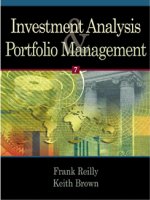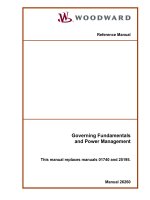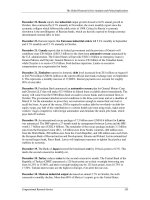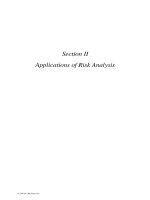advances in Investment Analysis and Portfolio Management phần 1 pptx
Bạn đang xem bản rút gọn của tài liệu. Xem và tải ngay bản đầy đủ của tài liệu tại đây (268.64 KB, 17 trang )
LEONARDO DA VINCI
Transfer of Innovation
Kristina Levišauskait÷
Investment Analysis and Portfolio Management
Leonardo da Vinci programme project
„Development and Approbation of Applied Courses
Based on the Transfer of Teaching Innovations
in Finance and Management for Further Education
of Entrepreneurs and Specialists in Latvia, Lithuania and Bulgaria”
Vytautas Magnus University
Kaunas, Lithuania
2010
Investment Analysis and Portfolio Management
2
Table of Contents
Introduction ………………………………………………………………………… 4
1. Investment environment and investment management process………………… 7
1.1 Investing versus financing……………………………………………………7
1.2. Direct versus indirect investment …………………………………………….9
1.3. Investment environment…………………………………………………… 11
1.3.1. Investment vehicles ………………………………………………… 11
1.3.2. Financial markets…………………………………………………… 19
1.4. Investment management process…………………………………………….23
Summary………………………………………………………………………… 26
Key-terms…………………………………………………………………………28
Questions and problems………………………………………………………… 29
References and further readings………………………………………………… 30
Relevant websites…………………………………………………………………31
2. Quantitative methods of investment analysis…………………………………… 32
2.1. Investment income and risk………………………………………………….32
2.1.1. Return on investment and expected rate of return………………… 32
2.1.2. Investment risk. Variance and standard deviation………………… 35
2.2. Relationship between risk and return……………………………………… 36
2.2.1. Covariance……………………………………………………………36
2.2.2. Correlation and Coefficient of determination……………………… 40
2.3. Relationship between the returns on stock and market portfolio……………42
2.3.1. Characteristic line and Beta factor…………………………………….43
2.3.2. Residual variance…………………………………………………… 44
Summary………………………………………………………………………… 45
Key-terms………………………………………………………………………….48
Questions and problems………………………………………………………… 48
References and further readings………………………………………………… 50
3. Theory for investment portfolio formation……………………………………… 51
3.1. Portfolio theory………………………………………………………………51
3.1.1. Markowitz portfolio theory………………………………………… 51
3.1.2. The expected rate of return and risk of portfolio…………………… 54
3.2. Capital Asset Pricing Model…………………………………………………56
3.3. Arbitrage Price Theory………………………………………………………59
3.4. Market Efficiency Theory……………………………………………………62
Summary………………………………………………………………………… 64
Key-terms………………………………………………………………………….66
Questions and problems……………………………………………………………67
References and further readings………………………………………………… 70
4. Investment in stocks………………… 71
4.1. Stock as specific investment……………………………………………… 71
4.2. Stock analysis for investment decision making………………………………72
4.2.1. E-I-C analysis……………………………………………………….73
4.2.2. Fundamental analysis……………………………………………… 75
4.3. Decision making of investment in stocks. Stock valuation………………… 77
4.4. Formation of stock portfolios……………………………………………… 82
4.5. Strategies for investing in stocks…………………………………………… 84
Summary………………………………………………………………………… 87
Key-terms…………………………………………………………………………90
Investment Analysis and Portfolio Management
3
Questions and problems………………………………………………………… 90
References and further readings………………………………………………… 93
Relevant websites……………………………………………………………… 93
5. Investment in bonds……………………………………………………………….94
5.1. Identification and classification of bonds……………………………………94
5.2. Bond analysis: structure and contents……………………………………… 98
5.2.1. Quantitative analysis………………………………………………… 98
5.2.2. Qualitative analysis………………………………………………… 101
5.2.3. Market interest rates analysis……………………………………… 103
5.3. Decision making for investment in bonds. Bond valuation……………… 106
5.4. Strategies for investing in bonds. Immunization………………………… 109
Summary…………………………………………………………………………113
Key-terms……………………………………………………………………… 116
Questions and problems………………………………………………………….117
References and further readings……………………………………………… 118
Relevant websites……………………………………………………………… 119
6. Psychological aspects in investment decision making………………………… 120
6.1. Overconfidence…………………………………………………………… 120
6.2. Disposition effect………………………………………………………… 123
6.3. Perceptions of investment risk…………………………………………… 124
6.4. Mental accounting and investing………………………………………… 126
6.5. Emotions and investment decisions……………………………………… 128
Summary……………………………………………………………………… 130
Key-terms……………………………………………………………………… 132
Questions and problems………………………………………………………….132
References and further readings…………………………………………………133
7. Using options as investments…………………………………………………… 135
7.1. Essentials of options……………………………………………………… 135
7.2. Options pricing…………………………………………………………… 136
7.3. Using options. Profit and loss on options………………………………… 138
7.4. Portfolio protection with options. Hedging……………………………… 141
Summary…………………………………………………………………………143
Key-tems…………………………………………………………………………145
Questions and problems………………………………………………………….146
References and further readings…………………………………………………147
Relevant websites……………………………………………………………… 147
8. Portfolio management and evaluation………………………………………… 148
8.1. Active versus passive portfolio management………………………………148
8.2. Strategic versus tactical asset allocation……………………………………150
8.3. Monitoring and revision of the portfolio………………………………… 152
8.4. Portfolio performance measures……………………………………………154
Summary…………………………………………………………………………156
Key-terms……………………………………………………………………… 158
Questions and problems………………………………………………………….158
References and further readings…………………………………………………160
Relevant websites……………………………………………………………… 161
Abbreviations and symbols used…………………………………………………….162
Bibliography…………………………………………………………………………164
Annexes…………………………………………………………………………… 165
Investment Analysis and Portfolio Management
4
Introduction
Motivation for Developing the Course
Research by the members of the project consortium Employers’ Confederation
of Latvia and Bulgarian Chamber of Commerce and Industry indicated the need for
further education courses.
Innovative Content of the Course
The course is developed to include the following innovative content:
• Key concepts of investment analysis and portfolio management which are
explained from an applied perspective emphasizing the individual
investors‘decision making issues.
• Applied exercises and problems, which cover major topics such as quantitative
methods of investment analysis and portfolio formation, stocks and bonds
analysis and valuation for investment decision making, options pricing and
using as investments, asset allocation, portfolio rebalancing, and portfolio
performance measures.
• Summaries, Key-terms, Questions and problems are provided at the end of
every chapter, which aid revision and control of knowledge acquisition during
self-study;
• References for further readings and relevant websites for broadening
knowledge and analyzing real investment environment are presented at the end
of every chapter.
Innovative Teaching Methods of the Course
The course is developed to utilize the following innovative teaching methods:
• Availability on the electronic platform with interactive learning and interactive
evaluation methods;
• Active use of case studies and participant centered learning;
• Availability in modular form;
• Utilizing two forms of learning - self-study and tutorial consultations;
• Availability in several languages simultaneously.
Target Audience for the Course
The target audience is: entrepreneurs, finance and management specialists from
Latvia, Lithuania and Bulgaria.
Investment Analysis and Portfolio Management
5
The course assumes little prior applied knowledge in the area of finance.
The course is intended for 32 academic hours (2 credit points).
Course Objectives
Investment analysis and portfolio management course objective is to help
entrepreneurs and practitioners to understand the investments field as it is currently
understood and practiced for sound investment decisions making. Following this
objective, key concepts are presented to provide an appreciation of the theory and
practice of investments, focusing on investment portfolio formation and management
issues. This course is designed to emphasize both theoretical and analytical aspects of
investment decisions and deals with modern investment theoretical concepts and
instruments. Both descriptive and quantitative materials on investing are presented.
Upon completion of this course the entrepreneurs shall be able:
• to describe and to analyze the investment environment, different types of
investment vehicles;
• to understand and to explain the logic of investment process and the
contents of its’ each stage;
• to use the quantitative methods for investment decision making – to
calculate risk and expected return of various investment tools and the
investment portfolio;
• to distinguish concepts of portfolio theory and apply its’ principals in the
process of investment portfolio formation;
• to analyze and to evaluate relevance of stocks, bonds, options for the
investments;
• to understand the psychological issues in investment decision making;
• to know active and passive investment strategies and to apply them in
practice.
The structure of the course
The Course is structured in 8 chapters, covering both theoretical and analytical
aspects of investment decisions:
1. Investment environment and investment process;
2. Quantitative methods of investment analysis;
3. Theory of investment portfolio formation;
4. Investment in stocks;
Investment Analysis and Portfolio Management
6
5. Investment in bonds;
6. Psychological aspects in investment decision making;
7. Using options as investments;
8. Portfolio management and evaluation.
Evaluation Methods
As has been mentioned before, every chapter of the course contains
opportunities to test the knowledge of the audience, which are in the form of questions
and more involved problems. The types of question include open ended questions as
well as multiple choice questions. The problems usually involve calculations using
quantitative tools of investment analysis, analysis of various types of securities,
finding and discussing the alternatives for investment decision making.
Summary for the Course
The course provides the target audience with a broad knowledge on the key
topics of investment analysis and management. Course emphasizes both theoretical
and analytical aspects of investment decision making, analysis and evaluation of
different corporate securities as investments, portfolio diversification and management.
Special attention is given to the formulation of investment policy and strategy.
The course can be combined with other further professional education courses
developed in the project.
Investment Analysis and Portfolio Management
7
1. Investment environment and investment management process
Mini-contents
1.1. Investing versus financing
1.2. Direct versus indirect investment
1.3. Investment environment
1.3.1. Investment vehicles
1.3.2. Financial markets
1.4. Investment management process
Summary
Key terms
Questions and problems
References and further readings
Relevant websites
1.1. Investing versus financing
The term ‘investing” could be associated with the different activities, but the
common target in these activities is to “employ” the money (funds) during the time
period seeking to enhance the investor’s wealth. Funds to be invested come from
assets already owned, borrowed money and savings. By foregoing consumption today
and investing their savings, investors expect to enhance their future consumption
possibilities by increasing their wealth.
But it is useful to make a distinction between real and financial investments.
Real investments generally involve some kind of tangible asset, such as land,
machinery, factories, etc. Financial investments involve contracts in paper or
electronic form such as stocks, bonds, etc. Following the objective as it presented in
the introduction this course deals only with the financial investments because the key
theoretical investment concepts and portfolio theory are based on these investments
and allow to analyze investment process and investment management decision making
in the substantially broader context
Some information presented in some chapters of this material developed for
the investments course could be familiar for those who have studied other courses in
finance, particularly corporate finance. Corporate finance typically covers such issues
as capital structure, short-term and long-term financing, project analysis, current asset
management. Capital structure addresses the question of what type of long-term
financing is the best for the company under current and forecasted market conditions;
project analysis is concerned with the determining whether a project should be
undertaken. Current assets and current liabilities management addresses how to
Investment Analysis and Portfolio Management
8
manage the day-by-day cash flows of the firm. Corporate finance is also concerned
with how to allocate the profit of the firm among shareholders (through the dividend
payments), the government (through tax payments) and the firm itself (through
retained earnings). But one of the most important questions for the company is
financing. Modern firms raise money by issuing stocks and bonds. These securities are
traded in the financial markets and the investors have possibility to buy or to sell
securities issued by the companies. Thus, the investors and companies, searching for
financing, realize their interest in the same place – in financial markets. Corporate
finance area of studies and practice involves the interaction between firms and
financial markets and Investments area of studies and practice involves the interaction
between investors and financial markets. Investments field also differ from the
corporate finance in using the relevant methods for research and decision making.
Investment problems in many cases allow for a quantitative analysis and modeling
approach and the qualitative methods together with quantitative methods are more
often used analyzing corporate finance problems. The other very important difference
is, that investment analysis for decision making can be based on the large data sets
available form the financial markets, such as stock returns, thus, the mathematical
statistics methods can be used.
But at the same time both Corporate Finance and Investments are built upon a
common set of financial principles, such as the present value, the future value, the cost
of capital). And very often investment and financing analysis for decision making use
the same tools, but the interpretation of the results from this analysis for the investor
and for the financier would be different. For example, when issuing the securities and
selling them in the market the company perform valuation looking for the higher price
and for the lower cost of capital, but the investor using valuation search for attractive
securities with the lower price and the higher possible required rate of return on his/
her investments.
Together with the investment the term speculation is frequently used.
Speculation can be described as investment too, but it is related with the short-term
investment horizons and usually involves purchasing the salable securities with the
hope that its price will increase rapidly, providing a quick profit. Speculators try to buy
low and to sell high, their primary concern is with anticipating and profiting from
market fluctuations. But as the fluctuations in the financial markets are and become
Investment Analysis and Portfolio Management
9
more and more unpredictable speculations are treated as the investments of highest
risk. In contrast, an investment is based upon the analysis and its main goal is to
promise safety of principle sum invested and to earn the satisfactory risk.
There are two types of investors:
individual investors;
Institutional investors.
Individual investors are individuals who are investing on their own.
Sometimes individual investors are called retail investors. Institutional investors are
entities such as investment companies, commercial banks, insurance companies,
pension funds and other financial institutions. In recent years the process of
institutionalization of investors can be observed. As the main reasons for this can be
mentioned the fact, that institutional investors can achieve economies of scale,
demographic pressure on social security, the changing role of banks.
One of important preconditions for successful investing both for individual
and institutional investors is the favorable investment environment (see section 1.3).
Our focus in developing this course is on the management of individual
investors’ portfolios. But the basic principles of investment management are applicable
both for individual and institutional investors.
1.2. Direct versus indirect investing
Investors can use direct or indirect type of investing. Direct investing is
realized using financial markets and indirect investing involves financial
intermediaries.
The primary difference between these two types of investing is that applying
direct investing investors buy and sell financial assets and manage individual
investment portfolio themselves. Consequently, investing directly through financial
markets investors take all the risk and their successful investing depends on their
understanding of financial markets, its fluctuations and on their abilities to analyze and
to evaluate the investments and to manage their investment portfolio.
Contrary, using indirect type of investing investors are buying or selling
financial instruments of financial intermediaries (financial institutions) which invest
large pools of funds in the financial markets and hold portfolios. Indirect investing
relieves investors from making decisions about their portfolio. As shareholders with
the ownership interest in the portfolios managed by financial institutions (investment
Investment Analysis and Portfolio Management
10
companies, pension funds, insurance companies, commercial banks) the investors are
entitled to their share of dividends, interest and capital gains generated and pay their
share of the institution’s expenses and portfolio management fee. The risk for investor
using indirect investing is related more with the credibility of chosen institution and
the professionalism of portfolio managers. In general, indirect investing is more related
with the financial institutions which are primarily in the business of investing in and
managing a portfolio of securities (various types of investment funds or investment
companies, private pension funds). By pooling the funds of thousands of investors,
those companies can offer them a variety of services, in addition to diversification,
including professional management of their financial assets and liquidity.
Investors can “employ” their funds by performing direct transactions,
bypassing both financial institutions and financial markets (for example, direct
lending). But such transactions are very risky, if a large amount of money is
transferred only to one’s hands, following the well known American proverb “don't put
all your eggs in one basket” (Cambridge Idioms Dictionary, 2nd ed. Cambridge
University Press 2006). That turns to the necessity to diversify your investments. From
the other side, direct transactions in the businesses are strictly limited by laws avoiding
possibility of money laundering. All types of investing discussed above and their
relationship with the alternatives of financing are presented in Table 1.1.
Table 1.1.
Types of investing and alternatives for financing
Types of investing in the economy Alternatives for financing in the
economy
Direct investing
(through financial markets)
Raising equity capital or borrowing
in financial markets
Indirect investing
(through financial institutions)
Borrowing from f
inancial institutions
Direct transactions
Direct borrowing, partnership contracts
Companies can obtain necessary funds directly from the general public (those
who have excess money to invest) by the use of the financial market, issuing and
selling their securities. Alternatively, they can obtain funds indirectly from the general
public by using financial intermediaries. And the intermediaries acquire funds by
allowing the general public to maintain such investments as savings accounts,
Certificates of deposit accounts and other similar vehicles.
Investment Analysis and Portfolio Management
11
1.3. Investment environment
Investment environment can be defined as the existing investment vehicles in
the market available for investor and the places for transactions with these investment
vehicles. Thus further in this subchapter the main types of investment vehicles and the
types of financial markets will be presented and described.
1.3.1. Investment vehicles
As it was presented in 1.1, in this course we are focused to the financial
investments that mean the object will be financial assets and the marketable securities
in particular. But even if further in this course only the investments in financial assets
are discussed, for deeper understanding the specifics of financial assets comparison of
some important characteristics of investment in this type of assets with the investment
in physical assets is presented.
Investment in financial assets differs from investment in physical assets in
those important aspects:
• Financial assets are divisible, whereas most physical assets are not. An
asset is divisible if investor can buy or sell small portion of it. In case of
financial assets it means, that investor, for example, can buy or sell a small
fraction of the whole company as investment object buying or selling a number
of common stocks.
• Marketability (or Liquidity) is a characteristic of financial assets that is not
shared by physical assets, which usually have low liquidity. Marketability (or
liquidity) reflects the feasibility of converting of the asset into cash quickly and
without affecting its price significantly. Most of financial assets are easy to buy
or to sell in the financial markets.
• The planned holding period of financial assets can be much shorter than the
holding period of most physical assets. The holding period for investments is
defined as the time between signing a purchasing order for asset and selling the
asset. Investors acquiring physical asset usually plan to hold it for a long
period, but investing in financial assets, such as securities, even for some
months or a year can be reasonable. Holding period for investing in financial
assets vary in very wide interval and depends on the investor’s goals and
investment strategy.
Investment Analysis and Portfolio Management
12
• Information about financial assets is often more abundant and less costly to
obtain, than information about physical assets. Information availability shows
the real possibility of the investors to receive the necessary information which
could influence their investment decisions and investment results. Since a big
portion of information important for investors in such financial assets as stocks,
bonds is publicly available, the impact of many disclosed factors having
influence on value of these securities can be included in the analysis and the
decisions made by investors.
Even if we analyze only financial investment there is a big variety of financial
investment vehicles. The on going processes of globalization and integration open
wider possibilities for the investors to invest into new investment vehicles which were
unavailable for them some time ago because of the weak domestic financial systems
and limited technologies for investment in global investment environment.
Financial innovations suggest for the investors the new choices of investment
but at the same time make the investment process and investment decisions more
complicated, because even if the investors have a wide range of alternatives to invest
they can’t forgot the key rule in investments: invest only in what you really
understand. Thus the investor must understand how investment vehicles differ from
each other and only then to pick those which best match his/her expectations.
The most important characteristics of investment vehicles on which bases the
overall variety of investment vehicles can be assorted are the return on investment and
the risk which is defined as the uncertainty about the actual return that will be earned
on an investment (determination and measurement of returns on investments and risks
will be examined in Chapter 2). Each type of investment vehicles could be
characterized by certain level of profitability and risk because of the specifics of these
financial instruments. Though all different types of investment vehicles can be
compared using characteristics of risk and return and the most risky as well as less
risky investment vehicles can be defined. However the risk and return on investment
are close related and only using both important characteristics we can really
understand the differences in investment vehicles.
The main types of financial investment vehicles are:
• Short term investment vehicles;
• Fixed-income securities;
Investment Analysis and Portfolio Management
13
• Common stock;
• Speculative investment vehicles;
• Other investment tools.
Short - term investment vehicles are all those which have a maturity of one
year or less. Short term investment vehicles often are defined as money-market
instruments, because they are traded in the money market which presents the financial
market for short term (up to one year of maturity) marketable financial assets. The risk
as well as the return on investments of short-term investment vehicles usually is lower
than for other types of investments. The main short term investment vehicles are:
• Certificates of deposit;
• Treasury bills;
• Commercial paper;
• Bankers’ acceptances;
• Repurchase agreements.
Certificate of deposit is debt instrument issued by bank that indicates a
specified sum of money has been deposited at the issuing depository institution.
Certificate of deposit bears a maturity date and specified interest rate and can be issued
in any denomination. Most certificates of deposit cannot be traded and they incur
penalties for early withdrawal. For large money-market investors financial institutions
allow their large-denomination certificates of deposits to be traded as negotiable
certificates of deposits.
Treasury bills (also called T-bills) are securities representing financial
obligations of the government. Treasury bills have maturities of less than one year.
They have the unique feature of being issued at a discount from their nominal value
and the difference between nominal value and discount price is the only sum which is
paid at the maturity for these short term securities because the interest is not paid in
cash, only accrued. The other important feature of T-bills is that they are treated as
risk-free securities ignoring inflation and default of a government, which was rare in
developed countries, the T-bill will pay the fixed stated yield with certainty. But, of
course, the yield on T-bills changes over time influenced by changes in overall
macroeconomic situation. T-bills are issued on an auction basis. The issuer accepts
competitive bids and allocates bills to those offering the highest prices. Non-
competitive bid is an offer to purchase the bills at a price that equals the average of the
Investment Analysis and Portfolio Management
14
competitive bids. Bills can be traded before the maturity, while their market price is
subject to change with changes in the rate of interest. But because of the early maturity
dates of T-bills large interest changes are needed to move T-bills prices very far. Bills
are thus regarded as high liquid assets.
Commercial paper is a name for short-term unsecured promissory notes issued
by corporation. Commercial paper is a means of short-term borrowing by large
corporations. Large, well-established corporations have found that borrowing directly
from investors through commercial paper is cheaper than relying solely on bank loans.
Commercial paper is issued either directly from the firm to the investor or through an
intermediary. Commercial paper, like T-bills is issued at a discount. The most common
maturity range of commercial paper is 30 to 60 days or less. Commercial paper is
riskier than T-bills, because there is a larger risk that a corporation will default. Also,
commercial paper is not easily bought and sold after it is issued, because the issues are
relatively small compared with T-bills and hence their market is not liquid.
Banker‘s acceptances are the vehicles created to facilitate commercial trade
transactions. These vehicles are called bankers acceptances because a bank accepts the
responsibility to repay a loan to the holder of the vehicle in case the debtor fails to
perform. Banker‘s acceptances are short-term fixed-income securities that are created
by non-financial firm whose payment is guaranteed by a bank. This short-term loan
contract typically has a higher interest rate than similar short –term securities to
compensate for the default risk. Since bankers’ acceptances are not standardized, there
is no active trading of these securities.
Repurchase agreement (often referred to as a repo) is the sale of security with
a commitment by the seller to buy the security back from the purchaser at a specified
price at a designated future date. Basically, a repo is a collectivized short-term loan,
where collateral is a security. The collateral in a repo may be a Treasury security, other
money-market security. The difference between the purchase price and the sale price is
the interest cost of the loan, from which repo rate can be calculated. Because of
concern about default risk, the length of maturity of repo is usually very short. If the
agreement is for a loan of funds for one day, it is called overnight repo; if the term of
the agreement is for more than one day, it is called a term repo. A reverse repo is the
opposite of a repo. In this transaction a corporation buys the securities with an
Investment Analysis and Portfolio Management
15
agreement to sell them at a specified price and time. Using repos helps to increase the
liquidity in the money market.
Our focus in this course further will be not investment in short-term vehicles
but it is useful for investor to know that short term investment vehicles provide the
possibility for temporary investing of money/ funds and investors use these
instruments managing their investment portfolio.
Fixed-income securities are those which return is fixed, up to some
redemption date or indefinitely. The fixed amounts may be stated in money terms or
indexed to some measure of the price level. This type of financial investments is
presented by two different groups of securities:
• Long-term debt securities
• Preferred stocks.
Long-term debt securities can be described as long-term debt instruments
representing the issuer’s contractual obligation. Long term securities have maturity
longer than 1 year. The buyer (investor) of these securities is landing money to the
issuer, who undertake obligation periodically to pay interest on this loan and repay the
principal at a stated maturity date. Long-term debt securities are traded in the capital
markets. From the investor’s point of view these securities can be treated as a “safe”
asset. But in reality the safety of investment in fixed –income securities is strongly
related with the default risk of an issuer. The major representatives of long-term debt
securities are bonds, but today there are a big variety of different kinds of bonds,
which differ not only by the different issuers (governments, municipals, companies,
agencies, etc.), but by different schemes of interest payments which is a result of
bringing financial innovations to the long-term debt securities market. As demand for
borrowing the funds from the capital markets is growing the long-term debt securities
today are prevailing in the global markets. And it is really become the challenge for
investor to pick long-term debt securities relevant to his/ her investment expectations,
including the safety of investment. We examine the different kinds of long-term debt
securities and their features important to understand for the investor in Chapter 5,
together with the other aspects in decision making investing in bonds.
Preferred stocks are equity security, which has infinitive life and pay
dividends. But preferred stock is attributed to the type of fixed-income securities,
because the dividend for preferred stock is fixed in amount and known in advance.
Investment Analysis and Portfolio Management
16
Though, this security provides for the investor the flow of income very similar to that
of the bond. The main difference between preferred stocks and bonds is that for
preferred stock the flows are for ever, if the stock is not callable. The preferred
stockholders are paid after the debt securities holders but before the common stock
holders in terms of priorities in payments of income and in case of liquidation of the
company. If the issuer fails to pay the dividend in any year, the unpaid dividends will
have to be paid if the issue is cumulative. If preferred stock is issued as noncumulative,
dividends for the years with losses do not have to be paid. Usually same rights to vote
in general meetings for preferred stockholders are suspended. Because of having the
features attributed for both equity and fixed-income securities preferred stocks is
known as hybrid security. A most preferred stock is issued as noncumulative and
callable. In recent years the preferred stocks with option of convertibility to common
stock are proliferating.
The common stock is the other type of investment vehicles which is one of
most popular among investors with long-term horizon of their investments. Common
stock represents the ownership interest of corporations or the equity of the stock
holders. Holders of common stock are entitled to attend and vote at a general meeting
of shareholders, to receive declared dividends and to receive their share of the residual
assets, if any, if the corporation is bankrupt. The issuers of the common stock are the
companies which seek to receive funds in the market and though are “going public”.
The issuing common stocks and selling them in the market enables the company to
raise additional equity capital more easily when using other alternative sources. Thus
many companies are issuing their common stocks which are traded in financial
markets and investors have wide possibilities for choosing this type of securities for
the investment. The questions important for investors for investment in common stock
decision making will be discussed in Chapter 4.
Speculative investment vehicles following the term “speculation” (see p.8)
could be defined as investments with a high risk and high investment return. Using
these investment vehicles speculators try to buy low and to sell high, their primary
concern is with anticipating and profiting from the expected market fluctuations. The
only gain from such investments is the positive difference between selling and
purchasing prices. Of course, using short-term investment strategies investors can use
for speculations other investment vehicles, such as common stock, but here we try to
Investment Analysis and Portfolio Management
17
accentuate the specific types of investments which are more risky than other
investment vehicles because of their nature related with more uncertainty about the
changes influencing the their price in the future.
Speculative investment vehicles could be presented by these different vehicles:
• Options;
• Futures;
• Commodities, traded on the exchange (coffee, grain metals, other
commodities);
Options are the derivative financial instruments. An options contract gives the
owner of the contract the right, but not the obligation, to buy or to sell a financial asset
at a specified price from or to another party. The buyer of the contract must pay a fee
(option price) for the seller. There is a big uncertainty about if the buyer of the option
will take the advantage of it and what option price would be relevant, as it depends not
only on demand and supply in the options market, but on the changes in the other
market where the financial asset included in the option contract are traded. Though, the
option is a risky financial instrument for those investors who use it for speculations
instead of hedging. The main aspects of using options for investment will be discussed
in Chapter 7.
Futures are the other type of derivatives. A future contract is an agreement
between two parties than they agree tom transact with the respect to some financial
asset at a predetermined price at a specified future date. One party agree to buy the
financial asset, the other agrees to sell the financial asset. It is very important, that in
futures contract case both parties are obligated to perform and neither party charges the
fee.
There are two types of people who deal with options (and futures) contracts:
speculators and hedgers. Speculators buy and sell futures for the sole purpose of
making a profit by closing out their positions at a price that is better than the initial
price. Such people neither produce nor use the asset in the ordinary course of business.
In contrary, hedgers buy and sell futures to offset an otherwise risky position in the
market.
Transactions using derivatives instruments are not limited to financial assets.
There are derivatives, involving different commodities (coffee, grain, precious metals,









